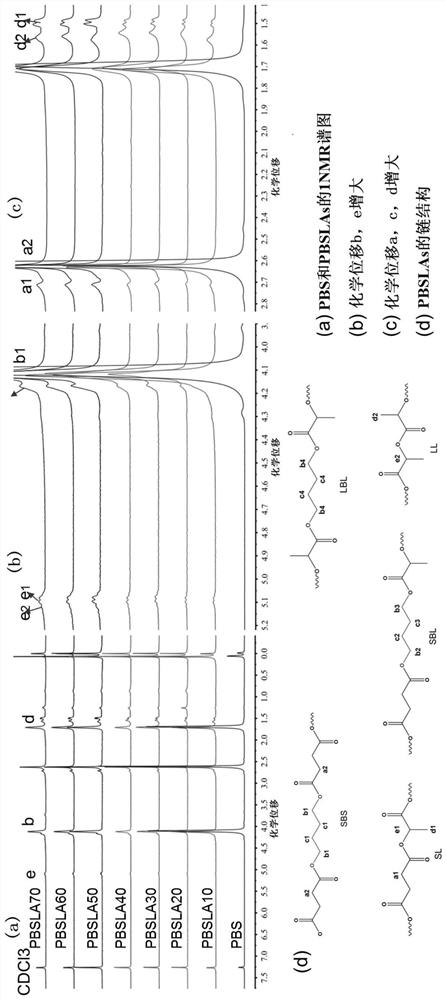Degradable copolyester as well as preparation method and application thereof
A technology of copolyester and polyester, applied in the field of degradable polymer materials, can solve the problems of high cost, low molecular weight, poor mechanical properties and efficient biodegradation of polyester, and achieve high molecular weight, simple method, excellent mechanical strength and The effect of toughness
- Summary
- Abstract
- Description
- Claims
- Application Information
AI Technical Summary
Problems solved by technology
Method used
Image
Examples
preparation example Construction
[0078] The invention provides a kind of preparation method of copolyester, comprises the steps:
[0079] Mixing the dibasic acid, dibasic alcohol and lactic acid monomers used to form the segment of the difficult-to-hydrolyze polyester, in the presence of a catalyst, temperature programming, esterification and polycondensation to obtain the copolyester;
[0080] or
[0081] The dibasic acid, dibasic alcohol or the lactic acid monomer used to form the segment of the difficult-to-hydrolyze polyester is programmed to increase the temperature in the presence of a catalyst, and firstly undergo esterification and polycondensation to obtain a low-molecular-weight segment that is difficult to hydrolyze permanent polyester or low molecular weight polylactic acid fragments;
[0082] Adding the above-mentioned low-molecular-weight segments of difficult-to-hydrolyzable polyester or low-molecular-weight polylactic acid during the esterification and polycondensation process of polylactic a...
Embodiment 1
[0114] A kind of degradable copolyester, its preparation method comprises the steps:
[0115] 10mol of 1,4-butanedioic acid, 15mol of 1,4-butanediol (excess), 1-7mol of lactic acid, tetraisopropyl titanate, stannous chloride, and 0.85-1.2g of composite catalyst composed of triethyl phosphate , starting at 150°C, the temperature is raised by 10°C every 10 minutes until it reaches 180°C, and the esterification is completed after no more water is released, and 3.5-5g of composite catalyst is added, vacuumized, and the temperature is raised by 10°C every 10 minutes to 230°C, and the reaction temperature is controlled at Continue the reaction at 230°C for 1 hour, add 1.5-3 g of catalyst, and continue the reaction for 1.5 hours to obtain random copolyesters PBSLA10, PBSLA20, PBSLA30, PBSLA40, PBSLA50, PBSLA60, and PBSLA70. The relevant data are shown in Table 1:
[0116] The copolyester prepared in Example 1 has the following molecular formula, and its basic properties are shown in...
Embodiment 2
[0122]A kind of degradable copolyester, its preparation method comprises the steps:
[0123] 10 mol of 1,4-butanedioic acid, 15 mol of 1,4-butanediol (excess), 0.5 mol of lactic acid, 160-180 °C temperature-programmed esterification for 2 hours, adding catalyst tetraisopropyl titanate 5.5 g, 2-ethyl Stannous hexanoate, 0.3 g, 200-230 ° C temperature programmed high vacuum polycondensation for 4.5 h to obtain random copolyester PBSLA5, its structural formula is the same as in Example 1.
[0124] In the formula x=120, p=60; The M of this random copolyester n =46200g / moL, tensile strength 42MPa, elongation at break 430%, melting point 105°C.
PUM
| Property | Measurement | Unit |
|---|---|---|
| tensile strength | aaaaa | aaaaa |
| tensile strength | aaaaa | aaaaa |
| tensile strength | aaaaa | aaaaa |
Abstract
Description
Claims
Application Information
 Login to View More
Login to View More - R&D
- Intellectual Property
- Life Sciences
- Materials
- Tech Scout
- Unparalleled Data Quality
- Higher Quality Content
- 60% Fewer Hallucinations
Browse by: Latest US Patents, China's latest patents, Technical Efficacy Thesaurus, Application Domain, Technology Topic, Popular Technical Reports.
© 2025 PatSnap. All rights reserved.Legal|Privacy policy|Modern Slavery Act Transparency Statement|Sitemap|About US| Contact US: help@patsnap.com



